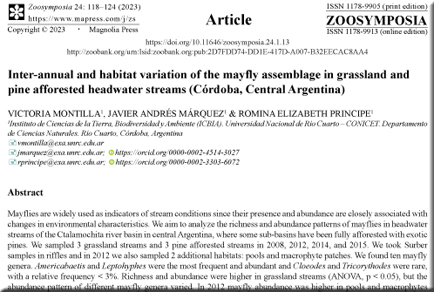Abstract
Mayflies are widely used as indicators of stream conditions since their presence and abundance are closely associated with changes in environmental characteristics. We aim to analyze the richness and abundance patterns of mayflies in headwater streams of the Ctalamochita river basin in central Argentina, where some sub-basins have been fully afforested with exotic pines. We sampled 3 grassland streams and 3 pine afforested streams in 2008, 2012, 2014, and 2015. We took Surber samples in riffles and in 2012 we also sampled 2 additional habitats: pools and macrophyte patches. We found ten mayfly genera. Americabaetis and Leptohyphes were the most frequent and abundant and Cloeodes and Tricorythodes were rare, with a relative frequency < 3%. Richness and abundance were higher in grassland streams (ANOVA, p < 0.05), but the abundance pattern of different mayfly genera varied. In 2012 mayfly abundance was higher in pools and macrophytes in the afforested streams (ANOVA, p < 0.05), but it was similar among habitats in grassland streams. Different species dominated different habitats and stream types, and some shared the same habitat. In riffles and pools, the dominant genera was similar for afforested and grassland streams, while in macrophyte the dominance varied according to the riparian vegetation. Distribution patterns are influenced by microhabitat characteristics, which may be conditioned by changes in riparian land uses.
References
- Brittain, J.E. (1982) Biology of mayflies. Annual Review of Entomology, 27, 119–147. https://doi.org/10.1146/annurev.en.27.010182.001003
- Brittain, J.E. (1990) Life history strategies in Ephemeroptera and Plecoptera. In: Campbell, I.C. (Eds.), Mayflies and Stoneflies: Life Histories and Biology. Dordrecht, Kluwer, pp. 1–12. https://doi.org/10.1007/978-94-009-2397-3_1
- Buitrago‐Guacaneme, A., Molineri, C., Cristóbal, L. & Dos Santos, D.A. (2022) The inter‐forest line could be the master key to track biocoenotic effects of climate change in a subtropical forest. Biotropica, 54 (1), 57–70. https://doi.org/10.1111/btp.13026
- Cabido, D., Cabido, M., Garré, S.M., Gorgas, J.A., Miatello, R., Rambaldi, S., Ravelo, A. & Tassile, J.L. (2003) Regiones Naturales de la Provincia de Córdoba. Agencia Córdoba D.A.C.yT, Dirección de Ambiente, Córdoba. [in Spanish]
- Dale, V.H. & Beyeler, S.C. (2001) Challenges in the development and use of ecological indicators. Ecological Indicators, 1 (1), 3–10. https://doi.org/10.1016/S1470-160X(01)00003-6
- Domínguez, E. & Fernández, H.R. (2009) Macroinvertebrados Bentónicos Sudamericanos: Sistemática y Biología. Tucumán: Fundación Miguel Lillo, 307 pp.
- Domínguez, E., Molineri, C., Pescador, M., Hubbard, M.D. & Nieto, C. (2006) Ephemeroptera of South America. Aquatic Biodiversity in Latin America (ABLA), Vol. 2. Pensoft, Sofia-Moscow.
- Farley, K.A., Jobbágy, E.G. & Jackson, R.B. (2005) Effects of afforestation on water yield: a global synthesis with implications for policy. Global Change Biology, 11 (10), 1565–1576. https://doi.org/10.1111/j.1365-2486.2005.01011.x
- Jobbágy, E.G., Vasallo, M., Farley, K.A., Piñeiro, G., Garbulsky, M.F., Nosetto, M.D., Jackson, R.B. & Paruelo, J.M. (2006) Forestació en pastizales: hacia una vision ´ integral de sus oportunidades y costos ecologicos. Agrociencia, 10 (2), 109–124. https://doi.org/10.31285/AGRO.10.934
- Karr, J.R. (1998) Rivers as sentinels: using the biology of rivers to guide landscape management. River ecology and management: lessons from the Pacific Coastal ecoregion. Springer, New York. https://doi.org/10.1007/978-1-4612-1652-0_20
- Little, C. & Lara, A. (2010) Restauración ecológica para aumentar la provisión de agua como un servicio ecosistémico en cuencas forestales del centro-sur de Chile. Bosque (Valdivia), 31 (3), 175–178. https://doi.org/10.4067/S0717-92002010000300001
- Marquez, J.A., Cibils, L., Principe, R.E. & Albariño, R.J. (2015) Stream macroinvertebrate communities change with grassland afforestation in central Argentina. Limnologica 53, 17–25. https://doi.org/10.1016/j.limno.2015.05.002
- Marquez, J.A., Rodríguez, M.P., Cibils Martina, L., Albariño, R.J. & Principe, R.E. (2021) Taxonomic and functional structure of aquatic insect assemblages in headwaters from upland grasslands (Córdoba, Argentina). Limnetica, 41 (1), 147–162. https://doi.org/10.23818/limn.41.12
- McGeoch, M.A. & Chown, S.L. (1998) Scaling up the value of bioindicators. Trends in Ecology & Evolution, 13 (2), 46–47. https://doi.org/10.1016/S0169-5347(97)01279-2
- Principe, R.E., Marquez, J.A., Martina Cibils, L., Jobbagy, E.G. & Albarino, R.J. (2015) Pine afforestation changes more strongly community structure than ecosystem functioning in grassland mountain streams. Ecological Indicators, 57, 366–375. https://doi.org/10.1016/j.ecolind.2015.04.033
- Richardson, J.S. (2019) Biological diversity in headwater streams. Water, 11, 366–385. https://doi.org/10.3390/w11020366
- Robinson, C.T., Gessner, M.O., Callies, K.A., Jolidon, C. & Ward, J.V. (2000) Larch needle breakdown in contrasting streams of an alpine glacial floodplain. Journal of the North American Benthological Society, 19 (2), 250–262. https://doi.org/10.2307/1468068
- Webster, J.R. & Benfield, E.F. (1986) Vascular plant breakdown in freshwater ecosystems. Annual review of ecology and systematics, 17 (1), 567–594. https://doi.org/10.1146/annurev.es.17.110186.003031
- Zúñiga de Cardoso, M. del C., Rojas de Hernández, A.M., & Mosquera de Aguilar, S. (1997) Biological aspects of Ephemeroptera in rivers of Southwestern Colombia (South America). In: Landolt, P. & Sartori, M. (Eds.), Ephemeroptera & Plecoptera. Biology Ecology-Systematics. (Proc. 8th Int. Conf. Ephemeroptera & 12th Int. Symp. Plecoptera, 14–20 August 1995, Losanne, Switzerland). Mauron Tinguely & Lacht SA, Fribourg Switzerland, pp. 261–268.


